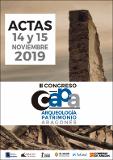Por favor, use este identificador para citar o enlazar a este item:
http://hdl.handle.net/10261/214682COMPARTIR / EXPORTAR:
 SHARE
BASE SHARE
BASE
|
|
| Visualizar otros formatos: MARC | Dublin Core | RDF | ORE | MODS | METS | DIDL | DATACITE | |

| Campo DC | Valor | Lengua/Idioma |
|---|---|---|
| dc.contributor.author | Rey Lanaspa, Javier | es_ES |
| dc.contributor.author | Clemente-Conte, Ignacio | es_ES |
| dc.contributor.author | Gassiot Ballbè, Ermengol | es_ES |
| dc.date.accessioned | 2020-06-17T19:31:14Z | - |
| dc.date.available | 2020-06-17T19:31:14Z | - |
| dc.date.issued | 2020 | - |
| dc.identifier.citation | Actas. III Congreso de Arqueología y Patrimonio Aragonés : 83-92 (2020) | es_ES |
| dc.identifier.isbn | 978-84-09-21258-3 | - |
| dc.identifier.uri | http://hdl.handle.net/10261/214682 | - |
| dc.description | Recoge los contenidos presentados a III Congreso de Arqueología y Patrimonio Aragonés (CAPA) | es_ES |
| dc.description.abstract | [EN] In this paper we want to present a preview of a series of places with rock art found in the Ordesa y Monte Perdido National Park, all of them belong to the municipality of Fanlo. The style of the paintings are classified in Levantine art and schematic art. Having studied the high mountain context in which all of them are found, it can be affirmed that, due to their location, they correspond to the northernmost and highest altitude cave paintings that are known in the Iberian Peninsula. We can also affirm that these coats with cave paintings mark a new limit in the dispersion map of postpalolitic rock art in which these territories were left out until now. | es_ES |
| dc.description.abstract | [ES] En este artículo queremos presentar un avance de una serie de abrigos con arte rupestre que se encuentran en el Parque Nacional de Ordesa y Monte Perdido, todos ellos en el municipio de Fanlo. Por el estilo de las pinturas se clasifican en arte levantino y arte esquemático. Estudiado el contexto de alta montaña en el que se encuentran todas ellas, se puede afirmar que, por su ubicación, corresponden con las pinturas rupestres más septentrionales y a mayor altitud que se conocen en la Península Ibérica. Igualmente se puede afirmar que estos abrigos con pinturas rupestres marcan un nuevo límite en mapa de dispersión del arte rupestre postpaleolítico en el que estos territorios hasta ahora quedaban al margen. | es_ES |
| dc.language.iso | spa | es_ES |
| dc.publisher | Colegio Oficial de Doctores y Licenciados en Filosofía y Letras y en Ciencias de Aragón | es_ES |
| dc.rights | openAccess | es_ES |
| dc.subject | Levantine and schematic rock art | es_ES |
| dc.subject | Post-Paleolithic cave paintings | es_ES |
| dc.subject | High Mountain | es_ES |
| dc.subject | Central Pyrenees | es_ES |
| dc.subject | Ordesa y Monte Perdido National Park | es_ES |
| dc.subject | Huesca | es_ES |
| dc.subject | Arte rupestre levantino y esquemático | es_ES |
| dc.subject | Pinturas rupestres post-paleolíticas | es_ES |
| dc.subject | Alta Montaña | es_ES |
| dc.subject | Pirineos Centrales | es_ES |
| dc.subject | Parque Nacional de Ordesa y Monte Perdido | es_ES |
| dc.title | Nuevas pinturas rupestres en el Parque Nacional de Ordesa y Monte Perdido (Fanlo, Huesca) | es_ES |
| dc.title.alternative | New paintings in the National Park of Ordesa and Monte Perdido (Fanlo, Huesca) | es_ES |
| dc.type | actas de congreso | es_ES |
| dc.description.peerreviewed | Peer reviewed | es_ES |
| dc.relation.publisherversion | https://arqueologiademuntanya.files.wordpress.com/2020/06/1.7_def.pdf | es_ES |
| dc.relation.csic | Sí | es_ES |
| oprm.item.hasRevision | no ko 0 false | * |
| dc.type.coar | http://purl.org/coar/resource_type/c_f744 | es_ES |
| item.openairetype | actas de congreso | - |
| item.grantfulltext | open | - |
| item.cerifentitytype | Publications | - |
| item.openairecristype | http://purl.org/coar/resource_type/c_18cf | - |
| item.fulltext | With Fulltext | - |
| item.languageiso639-1 | es | - |
| Aparece en las colecciones: | (IMF) Libros y partes de libros | |
Ficheros en este ítem:
| Fichero | Descripción | Tamaño | Formato | |
|---|---|---|---|---|
| Clemente-2020-Nuevas_pinturas.pdf | 2,34 MB | Adobe PDF |  Visualizar/Abrir |
CORE Recommender
Page view(s)
265
checked on 22-abr-2024
Download(s)
38
checked on 22-abr-2024
Google ScholarTM
Check
Altmetric
NOTA: Los ítems de Digital.CSIC están protegidos por copyright, con todos los derechos reservados, a menos que se indique lo contrario.
